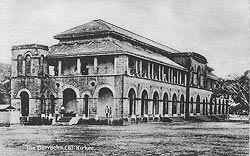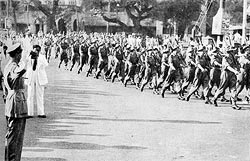Poona - First and Last
(Now called Pune)
 |
| The Barracks (B), Kirkee. (Click to enlarge) |
The Queen’s were stationed at Poona during the Regiment’s first year in India in 1825, and it was from there that 2nd Queen’s departed from India in 1947. It was, and still is, a city of considerable importance in Western India. In the early 19th century it was the capital of the Peshwa, the Ruler of the Maharatta Confederacy, and it was there that his army was finally defeated by the much smaller East India Company force at the battle of Kirkee in 1817. The Queen’s first arrived there in December 1825 glad to be rid of the humidity of Bombay where they had suffered much sickness, and the Regiment soon returned to good health on the crisp upland plains of Poona. It was there that the Regiment maintained a depot for its families and the reception of drafts from England during its long absence during the First Afghan War, and it was from there that it took part in operations during the Southern Maharatta Campaign in 1844.
The Regiment returned there just over one hundred years later when 2nd Queen’s arrived from Ranchi near Calcutta in June 1945 where the battalion had been reforming after its Chindit operations in North East Burma. There were then a large number of units and installations in the Poona area including the depot of the Indian Army Bombay Sappers and Miners and the arsenal at Kirkee a couple of miles from the city, an RAF station, the Signals School, and the Southern Command Education Centre at the Deccan College. In the early years of World War Two the college had been taken over by the Indian Army Tactical School which taught armoured warfare. The role changed to teaching jungle warfare after the Japanese entry into the war. But trees were in short supply on the plains around Poona. The nearest patch of jungle was at the Mahabeleshwar hill station 80 miles to the south. Consequently the Tactical School soon moved to the jungle ranges west of Dehra Dun in north-east India.
 |
| A Platoon of 2nd Battalion The Queen's Royal Regiment marching past at Bombay. (Click to enlarge) |
The Queen’s were stationed initially at Uruli, seventeen miles from Poona, before moving in September after the war with Japan was over to a mainly tented camp on the Pashan Plain four miles to the west of the city. Due to the loss of nearly all its Chindit veterans through repatriation (Operation Python) it was a very different battalion from 1944. It had an artillery commanding officer, Lieutenant Colonel H.G.de Jacobi du Vallon DSO, MC, who had taken over when it absorbed another Chindit unit, 60th Regiment RA, and it had been further made up to strength by Royal Welch Fusiliers and six Australian Forces officers. Additional mixed drafts continued to be received as the process of release of those who had served in the war gathered momentum. The battalion became part of 72nd Brigade which also included the 2nd Leicesters, 1st Essex, 2nd Borders, 2nd Manchesters, 146 Regiment Royal Armoured Corps (Duke of Wellington’s) and the Maharatta Light Infantry.
There was plenty of opportunity for games at Pashan Camp. Inter-company competitions were held at football, hockey and athletics and the battalion teams distinguished themselves at Poona Area level at these sports. Cricket, and later rugger, were also played with success against other units. Internal security had become the primary operational role, and drills for crowd dispersal were much practised. In October 1945 the battalion moved briefly to Bombay to quell communal riots, but was employed in guarding vital points and was not called into action.
In February 1946 2nd Queen’s returned to Bombay with the rest of 72nd Brigade. The occasion was the Royal Indian Navy mutiny which led to major rioting in the city which lasted for three days. This time the battalion was heavily engaged. It returned to Poona on 12th March after which 72nd Brigade broke up, and the battalion said farewell to 2nd Leicesters which had been its companion throughout the war. Later the battalion also said goodbye to its six Australian officers who returned to their own country.
In July Pashan Camp was taken over by the 4th Indian Division and 2nd Queen’s moved to Kharakavasla South Camp on the shores of Lake Fife twelve miles from Poona. During the war the lake had been used for combined operations training. Kharakavasla is now the home of the Indian Military Academy. In 1946 the accommodation consisted of Nissen huts and bamboo bashas built on a series of levels on the hill side above the lake. Fortunately the move into more rain-resistant accommodation than tents had been completed before the arrival of the monsoon. The surrounding country was better suited for training than Pashan, but the local facilities for entertainment were virtually non-existent and games were restricted by there being level ground for only one football field. However each company was able to spend one week at the Poona Holiday Home, and some soldiers were able to take leave at the Colaba Holiday Camp outside Bombay. Moreover as the weather improved the advantages of a camp on the shores of the lake became more apparent and the excellent facilities for swimming and sailing were much enjoyed.
In November 1946 as political unrest increased in expectation of independence it became necessary to detach one company to the Mahad area some hundred miles from Poona where communal rioting had broken out, but it was back in time for Christmas which was celebrated in style with the battalion concert party providing several first class shows.
The New Year dawned with the news that the battalion was to return to England and from there to move to West Germany to join the British Army of the Rhine. Prior to their departure the Warrant Officers and Sergeants received a present of a silver salver from their opposite numbers in the Bombay Sappers and Miners with whom they had established a close relationship. On the 17th January the battalion sailed from Bombay in H.T. Highland Princess. An officer who was with the battalion has recalled the final scenes:
“The evident bewilderment of the faithful camp followers, the char-wallahs, the dhobis, the dharzis and many others, that the British Army was actually going.
The Highland Princess carrying ourselves and the 3rd Dragoon Guards, the Carbineers, sailed away out to the ocean past the Gateway of India. I don’t think we were oppressed by being the end of a line - perhaps we were too young - but it had been a wonderful experience.
The arrival at the London Docks at Tilbury was on a cold damp evening in February. There on the dockside to greet us were four straight figures lined up with caps square down and greatcoats buttoned to the neck, one of them our new Commanding Officer, Lieutenant Colonel L.C. East DSO, OBE. We were home to be converted into a proper Queen’s regular battalion, but even so we felt that what had been done in the Regiment’s last tour in India was not unworthy of our predecessors.”
Following disembarkation 2nd Queen’s moved to a hutted camp at Crowborough in Sussex, arriving there with two inches of snow on the ground. Poona was already a dream, and for many their only experience of India, but one to savour for many years to come.
Related
